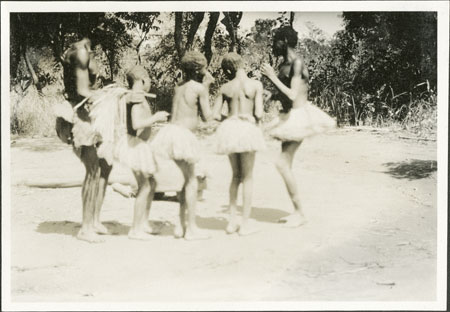Zande circumcision initiates dancing

104 x 78 mm | Print gelatin silver
There are records relating to alternative images that we do not have scans for in the database:
1998.341.498.1 - Negative film nitrate , (104 x 78 mm)
1998.341.498.1 - Negative film nitrate , (104 x 78 mm)
Condition:
Overall residual chemical staining + fading [EE 1989]
Date of Print:
Unknown
Previous PRM Number:
EP.A.498
Previous Other Number:
37 2
Accession Number:
1998.341.498.2
Description:
A group of boy circumcision initiates (agangasi) wearing grass fibre skirts, in a line performing a circumcision dance (gbere agangasi) with their sponsor (identifed as Yakobo) standing beside them holding a spray of plant leaves.
A wooden dance gong (gugu) can just be seen behind them.
Photographer:
Edward Evan Evans-Pritchard
Date of Photo:
1927 - 1930
Region:
[Southern Sudan] Western Equatoria Yambio
Group:
Zande
NamedPerson:
Yakobo
PRM Source:
Edward Evan Evans-Pritchard
Acquired:
Donated 1966
Other Owners:
E. E. Evans-Pritchard Collection
Class:
Clothing Ritual , Body Art , Dance , Music
Keyword:
Body Art Paint , Musical Instrument
Activity:
Ritual Activity , Dancing
Event:
Ceremony Circumcision , Dance
Documentation:
Original catalogue lists in Manuscript Collections. Additional material in related documents files. [CM 27/9/2005]
Primary Documentation:
PRM Accession Records - [1966.27.21] G PROFESSOR E.
E.
EVANS-PRITCHARD; INST.
OF SOCIAL ANTHROPOLOGY, 51 BANBURY RD.
OXFORD - S.
SUDAN, AZANDE TRIBE.
Box of negatives in envelopes.
Nos.
1 - 400
Added Accession Book Entry - [In pencil in column] Catalogue room.
[1966.27.23] G PROFESSOR E. E. EVANS-PRITCHARD; INST. OF SOCIAL ANTHROPOLOGY, 51 BANBURY RD. OXFORD - S. SUDAN, AZANDE TRIBE. Box of prints in envelopes, nos. 1 - 400 (prints of negatives in 1966.27.21)
Manual Catalogues [typewritten, entitled "Zande Photographs (E-P)"] - 498. Circumcision dance (Yakobo's Agangasi) 37/2
Notes on card mount m/s pencil - "RCS overall + fading 8.89"
Added Accession Book Entry - [In pencil in column] Catalogue room.
[1966.27.23] G PROFESSOR E. E. EVANS-PRITCHARD; INST. OF SOCIAL ANTHROPOLOGY, 51 BANBURY RD. OXFORD - S. SUDAN, AZANDE TRIBE. Box of prints in envelopes, nos. 1 - 400 (prints of negatives in 1966.27.21)
Manual Catalogues [typewritten, entitled "Zande Photographs (E-P)"] - 498. Circumcision dance (Yakobo's Agangasi) 37/2
Notes on card mount m/s pencil - "RCS overall + fading 8.89"
Other Information:
In The Azande (OUP, 1971) p.113 E.
E.
Evans-Pritchard notes that 'when Czekanowski carried out his researches in the years 1907-8 circumcision was in process of being introduced and had indeed become so much the fashion that adults were undergoing the operation...
It is remarkable that in so short a time the practice had come to be regarded as so much a Zande custom that aboro pito 'the uncircumcised', had become a scornful epithet used in reference to other peoples....
My informants said that it [circumcision] came to them from the Amadi...
Mgr Lagae says that the Azande of the south were initiated into the practice by the Mangbetu and the Abarambo, those of the north by the Amadi.' P.
Baxter & A.
Butt (London AIA, 1953 pages 73-4) discuss C.R.
Lagae's published accounts of circumcision among the Azande, noting that it takes place near a stream and away from settlement, the period of seclusion being about two months and the boys residing in specially made huts there.
The period is brought to a close with a feast and dancing, after which the boy takes a new name and social position.
[Chris Morton 16/10/2003] In The Azande (OUP 1971, page 103) E.
E.
Evans-Pritchard notes that '[f]rom the south came ..
the circumcision dance (gbere agangasi) together with the operation...' [Chris Morton 8/10/2003] In his article 'An Account of the Zande' Sudan Notes and Records (Vol.
IX, No.
1, 1926 p.29-30) P.M.
Larken notes that 'After a little time, during which the boy goes naked, a short skirt, rather like a ballet dancer's, is made of special strips of fine fibre, about nine inches or a foot in length.
A loin cloth cannot be worn until the wound has healed....
Special songs and dances take place in camp.
The dance step consists of a sideways twisting of the body from the hips, the feet hardly moving, causing the skirt to swing outwards and make a sort of frill round the loins.'
Recorder:
Christopher Morton 14/11/2003 [Southern Sudan Project]

